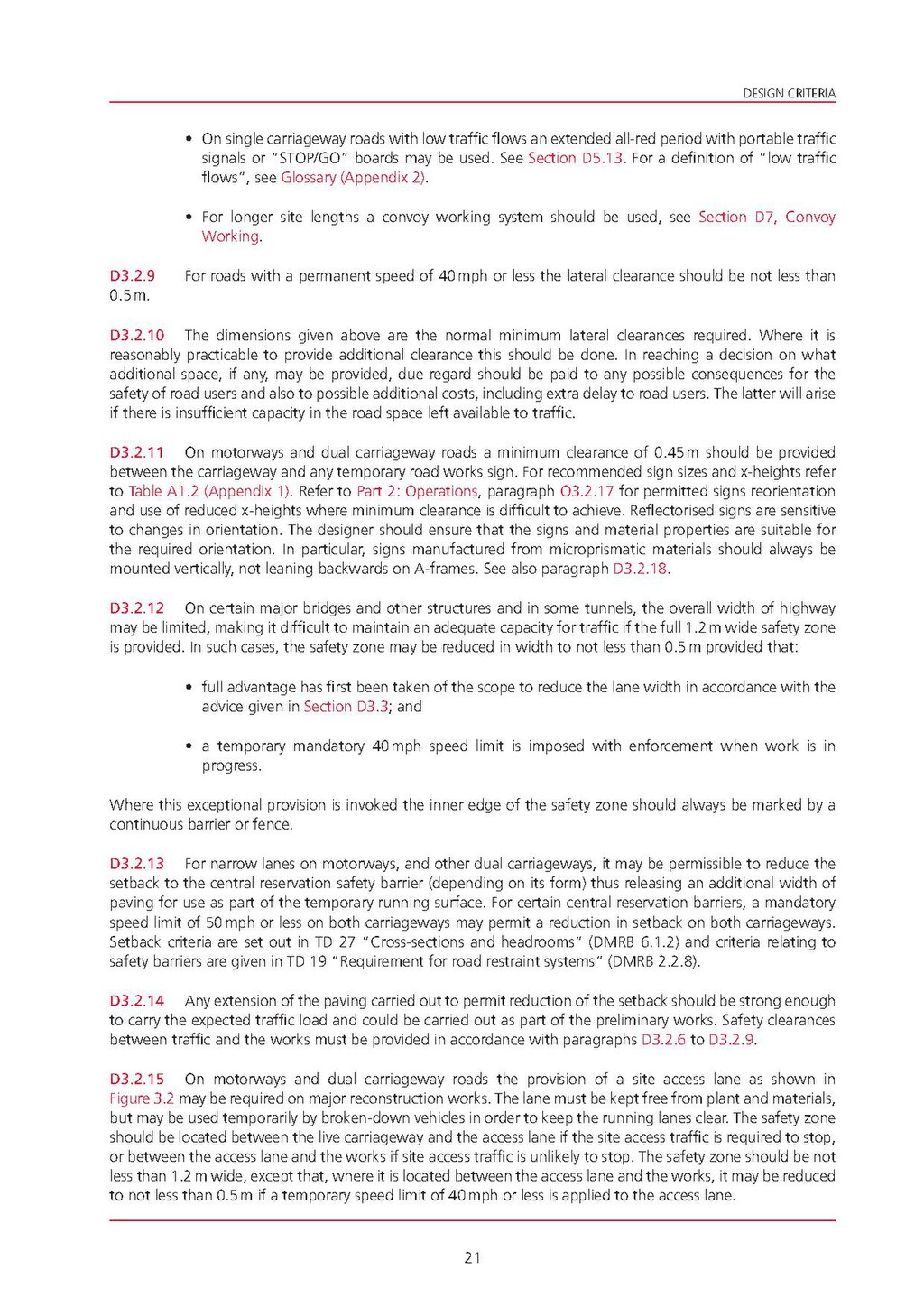- On single carriageway roads with low traffic flows an extended all-red period with portable traffic signals or "STOP/GO" boards may be used. See Section D5.13. For a definition of "low traffic flows", see Glossary (Appendix 2).
- For longer site lengths a convoy working system should be used, see Section D7, Convoy Working.
D3.2.9 For roads with a permanent speed of 40 mph or less the lateral clearance should be not less than 0.5 m.
D3.2.10 The dimensions given above are the normal minimum lateral clearances required. Where it is reasonably practicable to provide additional clearance this should be done. In reaching a decision on what additional space, if any, may be provided, due regard should be paid to any possible consequences for the safety of road users and also to possible additional costs, including extra delay to road users. The latter will arise if there is insufficient capacity in the road space left available to traffic.
D3.2.11 On motorways and dual carriageway roads a minimum clearance of 0.45 m should be provided between the carriageway and any temporary road works sign. For recommended sign sizes and x-heights refer to Table A1.2 (Appendix 1). Refer to Part 2: Operations, paragraph O32.17 for permitted signs reorientation and use of reduced x-heights where minimum clearance is difficult to achieve. Reflectorised signs are sensitive to changes in orientation. The designer should ensure that the signs and material properties are suitable for the required orientation. In particular, signs manufactured from microprismatic materials should always be mounted vertically, not leaning backwards on A-frames. See also paragraph D3.2.18.
D3.2.12 On certain major bridges and other structures and in some tunnels, the overall width of highway may be limited, making it difficult to maintain an adequate capacity for traffic if the full 1.2 m wide safety zone is provided. In such cases, the safety zone may be reduced in width to not less than 0.5 m provided that:
- full advantage has first been taken of the scope to reduce the lane width in accordance with the advice given in Section D33, and
- a temporary mandatory 40 mph speed limit is imposed with enforcement when work is in progress.
Where this exceptional provision is invoked the inner edge of the safety zone should always be marked by a continuous barrier or fence.
D3.2.13 For narrow lanes on motorways, and other dual carriageways, it may be permissible to reduce the setback to the central reservation safety barrier (depending on its form) thus releasing an additional width of paving for use as part of the temporary running surface. For certain central reservation barriers, a mandatory speed limit of 50 mph or less on both carriageways may permit a reduction in setback on both carriageways. Setback criteria are set out in TD 27 "Cross-sections and headrooms" (DIVIRB 6.1.2) and criteria relating to safety barriers are given in TD 19 "Requirement for road restraint systems" (DIVIRB 2.2.8).
D3.2.14 Any extension of the paving carried out to permit reduction of the setback should be strong enough to carry the expected traffic load and could be carried out as part of the preliminary works. Safety clearances between traffic and the works must be provided in accordance with paragraphs D3.2.6 to D3.2.9.
D3.2.15 On motorways and dual carriageway roads the provision of a site access lane as shown in Figure 3.2 may be required on major reconstruction works. The lane must be kept free from plant and materials, but may be used temporarily by broken-down vehicles in order to keep the running lanes clear. The safety zone should be located between the live carriageway and the access lane if the site access traffic is required to stop, or between the access lane and the works if site access traffic is unlikely to stop. The safety zone should be not less than 1.2 m wide, except that, where it is located between the access lane and the works, it may be reduced to not less than 0.5 m if a temporary speed limit of 40 mph or less is applied to the access lane.
21
